Various existing learning environments could scale to MOOC size and benefit learners by adding the social elements now missing, from citizen science to simulations, games, virtual reality, and augmented reality.

Todd Bryant, Language Technology Specialist, Dickinson College
While those of us in instructional technology are familiar with the rise and fall of "disruptive" and "revolutionary" technologies in education, the amount of coverage from the popular media has made this Gardner hype cycle path appear particularly extreme. Initially we heard the overblown promises of MOOCs providing elite university educations for free. Then followed the high-profile failures, including the San Jose experiment of replacing entry-level courses with MOOCs and Udacity's subsequent announcement that the company would focus on professional vocation training.
Despite the abrupt dose of reality, it appears that MOOCs will continue for the foreseeable future. In a recent report from HarvardX and MITx, participant growth was found to be linear, meaning that while the exponential growth appears to have ended, the user base is growing despite the backlash.1 Major platforms continue to find support for further course development and expanded partnerships: EdX recently announced a partnership with the Smithsonian and Microsoft to offer additional courses, and Coursera has partnered with Google and Instagram.
For MOOCs to be considered valued spaces for learning, they need to adopt aspects of the earlier connectivist MOOCs (cMOOCs) and reintroduce social elements. While it might seem logical to copy our largest traditional course format when creating MOOCs, the importance of social connections in learning has been recognized in environments highly relevant to MOOCs. Researchers have described social elements as key to self-directed learning.2 Referring to online learning environments in particular, Kreijns, Kirschner, and Jochems identified two pitfalls for social learning online: "the assumption that social interaction can be taken for granted and that it will automatically happen" and "forgetting the social-psychological/social dimension of social interaction that is salient in non-task contexts."3 These shortcomings have been widely recognized in xMOOCs, with even the president of Stanford saying, "When I think about MOOCs, the advantage — the ability to prepare a course and offer it without personal interaction — is what makes them inexpensive and makes them very limited."4
While distinct, these two separate forms of learning networks — cMOOCs and open content–focused xMOOCs — need not conflict. In addition to the content, learners require opportunities to reflect on and use the new information they have acquired. Bringing together learners around a common topic or theme is what MOOCs have to offer the open content movement as a whole. By creating these communities, MOOCs can create a cycle of using, producing, and improving open content on the web. For this to happen, courses need to have interaction built into their platforms and consider the advantages of complete openness at scale.
Platforms with Support for Social Interaction
The major MOOC providers' platforms bear a striking resemblance to the learning management systems popular on most campuses: The primary function is to provide content, with the only tool for learner-to-learner interaction frequently being the discussion board. The central content is almost always video lectures, divided into segments and often with multiple-choice questions interspersed. While many pundits claimed MOOCs would revolutionize education, really they reverted to the most traditional and hierarchical model of online education. One of the original MOOC creators, George Siemens, lamented, "One of the drawbacks of MOOCs are [sic] that they've really instantiated the worst pedagogical practices, and they've allowed us to broadcast [them] and export [them] more effectively."5
Although changes are limited, we have begun to see a shift back toward the social within the larger xMOOC platforms. Coursera has introduced hubs where course participants can meet in the real world. Many of the courses within the major MOOC platforms provide participants with the ability to connect via popular social media platforms as well, usually via a common Twitter hashtag, Facebook page, links to regular Google Hangouts, or OpenStudy. While an improvement, these tools generally remain underused because the course design continues to mimic a traditional lecture course.
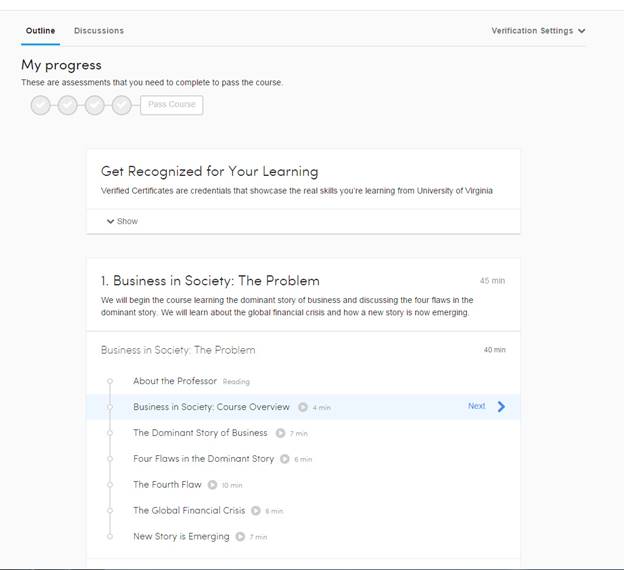
Coursera screenshot
The clearest example of an attempt to reintroduce aspects of the cMOOCs into an xMOOC plaform was the DALMOOC. The course, "Data Analytics and Learning," organized by George Siemens, Carolyn Rosé, Dragan Gasevic, Ryan Baker, and others, targeted those interested in the role of social interaction, technology, and underlying data. Two distinct tracks were offered to students, the traditional xMOOC method of content distribution or a cMOOC style that involved greater self-direction and discussion.
Two new tools added to the EdX platform for the DALMOOC create learning networks around common goals, organize learners into groups, and facilitate discussion and collaboration. The first tool, ProSolo [http://dalmooc.prosolo.ca/prosolo/about.xhtml], allows learners to organize themselves around learning goals for the course. Learners can select competencies they would like to pursue, then ProSolo suggests partners based on common interests. The other tool, Bazaar [https://linkresearchlab.org/dalmooc/tools/all/], matches students on a per-assignment basis within a chat room and then presents them with prompts for the discussion or collaboration. Unlike the add-ons in other courses, these tools form a core part of the course and are integrated with both the assignments and course goals.
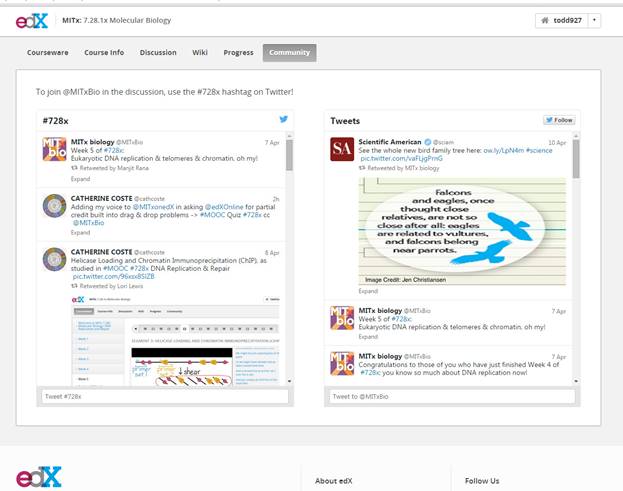
EdX screenshot
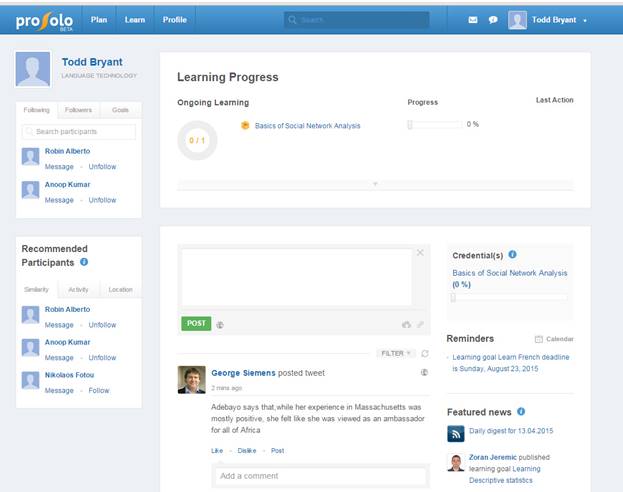
ProSolo screenshot
A complete and separate platform, NovoEd (previously Venture Lab), differentiates itself from other providers by emphasizing collaboration. All courses on NovoEd contain a mix of group and individual assignments. For group assignments, the platform provides the ability for learners to create and join teams. Limited in size depending on the course, these teams are intended to remain small. As with the DALMOOC, the overall course design involves learner collaboration as a member of a team.
Foreign Language Learners Communicate
While providing support for small group discussions and collaboration, future MOOCs should consider innovative course ideas that not only can scale but also would benefit from the open online environment. One area where a social aspect is always deemed critical for a course is foreign languages. Anyone who has taught or taken a course in a foreign language is familiar with the partner activities designed to have students communicate as much as possible. This format may be why foreign languages are underrepresented among lecture-formatted MOOCs. A recent study of the handful of language MOOCs found that only three met the basic requirements of a cMOOC and generally lacked the social and interactive environment desirable in an online language course.6
Despite the apparent conflict between the methodology of a language course and most MOOCs, they offer the perfect example of how openness online can create opportunities at scale. While language learners have little trouble finding authentic content, it is difficult to find structured content that also provides the opportunity to practice and receive feedback. Connecting language learners with native speakers as part of a language exchange can help bridge the feedback gap while also providing verbal practice. Computer-mediated communication, a well-established field of study in foreign languages, uses computers to connect learners with native speakers. While it would be premature to claim that connecting students with native speakers online has become mainstream, most foreign language educators at least know about the practice and its benefits.
At least two MOOCs for foreign languages provide examples of these social exchanges. The Mixxer website offered a Spanish/English MOOC in the summer of 2013, and expanded to include French/English, German/English, and Spanish/English in 2014. The course used existing open content resources to create lessons centered on an activity with a language partner. In winter 2014–15 several Spanish universities offered a Spanish/English course as well, using Moodle as a platform. The MOOC also provided a function within Moodle similar to Bazaar from DALMOOC to connect language partners. When participants were ready for an exchange, they could enter a kind of virtual waiting room. When an English speaker and a Spanish speaker had entered the room, they were connected via video chat and given prompts for the Spanish and English portions of the exchange.
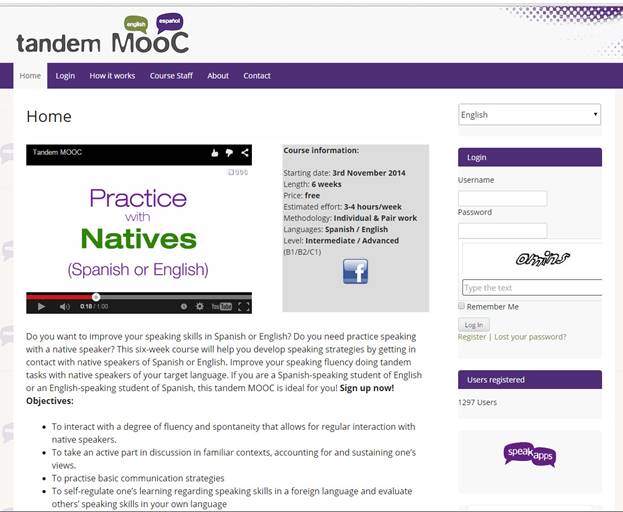
English/Spanish MOOC
Connecting Learners with a Common Goal
One way to both motivate students and provide them with the opportunity to practice what they've learned is to organize the course around a common project or goal. While a common practice in traditional courses, this approach might seem daunting when scaled to a MOOC. Fortunately, crowdsourcing projects already exist in a wide variety of academic fields. Participants can access activities relevant to the topic, and their submissions are evaluated by a community whose members provide feedback. Once users have submitted sufficient approved content, they often can assume the role of reviewer themselves. MOOCs could mimic this approach either by using the review process currently in place or by first vetting the content within the course before submitting to the crowdsourcing site.
Courses in computer science and programming have a wide array of options with potential projects for MOOCs looking to provide learners with hands-on experiences in a collaborative environment they are likely to experience as professionals. Because open-source projects require a community-based online presence with a process that requires submission, review, and publication, projects seek new members in all areas of development. For potential MOOCs on web development, both WordPress and Drupal provide guidelines along with a submission and approval process for those looking to add plugins and modules. For mobile devices, Android has communities based around its operating system as well as app development. The oldest and most famous project, Linux, seeks contributions as well. Ubuntu has its own community for desktop and server development.
These examples represent some of the most well-established communities, but almost anything imaginable in the area of technology has an open-source alternative group eager for help. Contributors for any of these projects do not need to be advanced users. Troubleshooting, support, and documentation are all needed and can also function as projects for intermediate-level users. MOOC users would need to understand the open-source project as a whole, but focus on one area to provide user support. OpenHatch and Mozilla from P2PU provides a template of how a MOOC course can work alongside an open course community as well, by first introducing the standard and processes of the community before having learners become active members.
Turning MOOC Participants into Citizen Scientists
Science is another area where crowdsourcing can allow learners to make tangible contributions as part of a team that benefits research. These citizen scientist projects ask participants to collect or analyze data that the project leaders then synthesize. Some of these projects have created simulations, often called scientific discovery games, that synthesize the results of scientific puzzles solved by participants, which in turn help researchers find patterns or structures more easily recognized by humans than computers. These include FoldIt for proteins, Eterna for RNA, and Nanocrafter [http://nanocrafter.org/] and Phylo for DNA. These projects also offer varying degrees of community research along with teaching and learning materials. MOOCs could supplement these resources by providing greater context to the games themselves, allowing for collaborative solutions for the most difficult puzzles, and connecting the content of course with their own scientific contributions.
Many citizen science projects ask amateurs to help with a variety of tasks in the real world that involve a learning and community component. Frequently they focus on data collection or cataloging and are part of an environmental science, biology, or astronomy project. By connecting MOOC learners with citizen science projects, participants would be exposed to content as well as the methods used by scientists. As members of a team, they contribute data to be analyzed and then published. One prominent example, the Magicada project, provides information about cicadas, lessons designed for science classes, data sets including time and location of cicadas, and citizen science projects looking for contributions. As with the simulations, these projects publicize their research, allowing participants to draw connections between their data and the system as a whole.
There are far too many citizen science projects to begin listing them here; a great place to start is the Cornell Lab of Ornithology, which maintains a searchable database. In addition to finding projects, the site also provides guidelines for setting up a citizen science project and adding it to the database. Another possible site for biologists and environmental scientists is iNaturalist. Note that the data collected can be exported in csv and kml formats for analysis as part of a course. Finally, NASA regularly seeks helps from amateurs, including a recent call for help identifying asteroids [http://www.topcoder.com/asteroids/].
Outside of the sciences, crowdsourcing most often focuses on information gathering to improve government or help nongovernmental organizations (NGOs) during natural disasters and conflicts. By joining a community and working together, learners have a positive impact while gaining real-life experience. These projects can overlap with courses in a number of subjects including government, political science, and international affairs. While submitting information often requires being on location, which frequently is difficult to reach or in a dangerous location, the projects also need help parsing images and information collected via social media. One of the easiest to provide help for is MicroMappers, which asks users to identify images of disasters, categorize severity, or geo-locate items. The results are then placed on a map for damage assessment and used by emergency responders. A more ambitious and open-ended option is OpenIDEO, which provides a platform that focuses on collaborative research and provides a method for submitting ideas and organizing a team around a "challenge" to improve the world in a tangible way. MOOCs would need to define a topic of research, gather information on the topic, and then submit ideas to the OpenIDEO community for feedback, with the final goal being the implementation of these ideas. "Crowdsourcing in the Humanitarian Network — An Analysis of the Literature" includes further information on crowdsourcing and organizing projects, as well as additional examples including human rights, natural disasters, and community organizing, along with a discussion of the challenges, potential, and dangers involved in each.
Providing Analysis along with the Content
Another way to connect learners as part of a MOOC is to engage them in a project for more open government. The most well-known case of crowdsourcing government data is the Guardian's use of the public to examine documents of expenses by MPs in search of questionable use of public funds. The newspaper provided a platform for users to highlight items of interest and provide context. A MOOC could offer a similar service to learners on any large, open data set by giving them the necessary background to understand the information as well as a platform to share and compare insights. Learners could gain a much broader and practical understanding than they would from an overview provided by lectures or readings. Databases from the ACLU on the NSA or torture could become material for a course on privacy or government power in the digital age. Wikileaks provides a searchable database on current topics as well. At the other end of the spectrum, governments and international institutions provide access to open data, any of which could benefit from analysis by a targeted and interested group; for example, the United States, United Kingdom, United Nations, World Bank, and International Monetary Fund.
The largest information crowdsourcing project in the world, Wikipedia, is also always looking for new authors. Unlike other crowdsourcing projects, Wikipedia offers a framework specifically tailored for educators to introduce authoring to their students as well as an unlimited breadth of topics. Organizers can get started via Wikipedia's outreach program, and traditional courses authoring Wikipedia are common enough that it is easy to find example syllabi online. A MOOC course focused on Wikipedia authoring could form a cycle of consuming as well as producing open content. While MOOCs involving Wikipedia editing aren't common, it has been done before. "DOC2013: Dialogues on Feminism and Technology" included an activity, Storming Wikipedia, to include more women in articles on technology and science. Other MOOCs could adapt a similar strategy of presenting the MOOC as an opportunity to promote understanding of a given topic and improve Wikipedia in the process.
MOOCs Can Be the Simulation
Simulations, another example of having learners work together as part of a learning experience, can also scale to very large numbers. They have been considered common practice in business and international relations departments for years. The simulations allow learners to understand how different factors work together within a larger system while also providing room for experimentation and failure, within a game environment. Generally speaking, these simulations have learners organized into teams that represent stakeholders within a scenario. Learners must do research on their own situation as well as the larger system to take the most advantageous actions available to them. Excellent resources developed in these areas can provide a foundation for a potential MOOC. Many commercial simulations support business courses, along with some free ones. Classroom Aid offers a good starting list with descriptions. For international relations, PaxSims reviews simulations on a regular basis and has an active community.
Outside of the traditional areas, any subject that can fit this model of stakeholders within a larger system can use simulations. Learners are assigned individually or as groups to represent powerful actors. For example, Professor Wesch became well known for his alternative use of a simulation in his cultural anthropology course. In the simulation, students divided into groups create their own culture. They create additional aspects of their culture as they learn more throughout the course. At the end of the course, these cultures become part of a world simulation in which they interact from different positions of power to resolve issues of resource scarcity.
Another potential model is the "Reacting to the Past" game series from Bard College. These games are designed for small classes, but the concept of choosing a point in history, usually a point of conflict over competing ideas or philosophies, and dividing the class into groups of stakeholders, could be scaled to a MOOC. Learners would receive background information concerning the point in history, along with the goals or aspirations of their particular group. In a large MOOC, these ideas would ideally be broad and allow learners to create their personas and align themselves with one or more groups: unions, nationalists, academics, politicians, business interests, etc. After groups were formed, positions articulated, and allegiances made, the outcome of the game would depend on their relative power and the actions available to each, with MOOC leaders determining consequences.
Environmental science has seen rapid growth in the number of simulations available for education. Many of these simulations are designed for a single user to experiment with variables to test various outcomes, but others include stakeholders and are meant to be played in groups, large or small. Learners can search for compromise and possible solutions to avoid the tragedy of the commons. "SMARTIC" is one example that focuses on competing interests for resources in the Arctic. Stakeholders include fishing and energy industries, coastal communities, environmentalists, and tourism. Participants need to understand their own interests as well as the impact of their actions on other stakeholders in order to decide on a final course of action. Again, this same model could be replicated to any situation where competing interests impact the environment. Learners would adopt a persona, research the topic to best represent their interests, then join with others in an attempt to achieve a positive outcome.
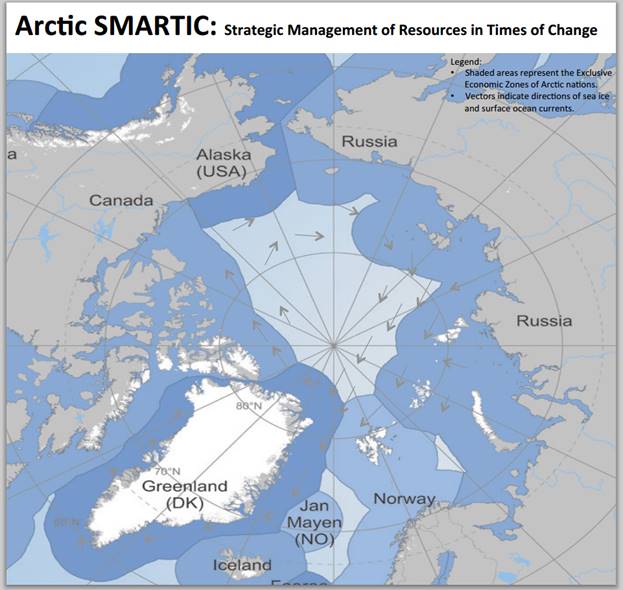
SMARTIC screenshot
Virtual Worlds as Collaborative Creations and Spaces
Virtual worlds frequently allow users to create their own simulations or scenarios and give users the ability to distribute them to the wider community. In a MOOC, individuals or groups of learners could create simulations to be played and reviewed by the other course participants. History courses have used simulations as a way of demonstrating to learners the interaction of a large number of actors with competing interests and the potentially large number of variables that contributed to the final outcome. Professor Shawn Graham from Carleton College gives an idea of how such an assignment could be presented with a MOOC. An advantage of such computer simulations is that they provide a clear opportunity to consider all factors that contributed to the final outcome. If a simulation consistently differs from reality, learners should be asked to provide an explanation of factors missing or incomplete within the virtual world and receive feedback from the community. Equally important is the opportunity to reflect on the reasons behind their choices in creating the simulation and the impact those will likely have on the simulation.
One of the goals of educators in the sciences is to have students encounter questions and then work together to solve a problem. Virtual worlds can provide this opportunity of learning via questioning and problem solving, such as the recently released Radix Endeavor. Players enter a virtual world whose inhabitants suffer from a myriad of problems. Players can help them by coming up with solutions in the game using math, engineering, and science. A MOOC could work in much the same way, social networks often function alongside of games by providing background information on problems encountered in the game, explanations of solutions, and overall guidance connecting individual problems with broader concepts.
Simulations can also be created using popular commercial games. Although the modding tools for commercial games are usually free, learners would need to purchase the game to run the simulations. Unlike virtual worlds, these games include variables and logic for determining power, resource scarcity, economics, diplomacy, and more. As with virtual worlds, it is important for learners to understand the interaction of these variables and how the simulation varies either via simplification, error, or omission from historical reality. Dickinson College, for example, had students conduct research and create simulations for use in future courses, applying the Civilization V SDK as part of a digital humanities grant. Most other commercial strategy games popular in education have tools for modding, including SimCity (SimCityPack), Total War series (Assembly Kit and TEd for each game), and Europa Universalis (Clausewitz Scenario Editor and Clausewitz EU4 Editor).
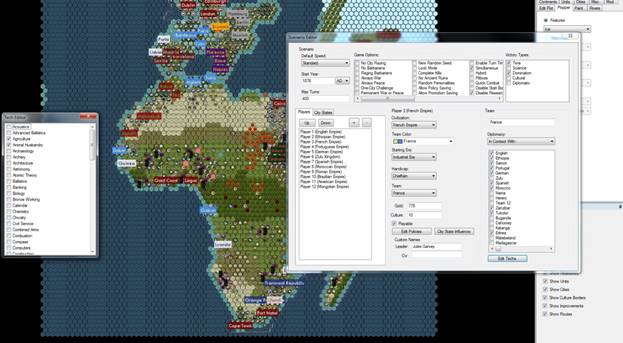
Civilization screenshot
Turning the Real World into a Collaborative Game
Alternate reality games are simulations played in the real world. For those not familiar with ARGs, players often join via an initial teaser or rabbit hole online. They receive information, puzzles, and possible actions, which taken together form a narrative. This narrative is often either a fictional conspiracy taking place in the present, a possible future, or an alternative past. ARGs are designed to be massive and encourage problem solving among groups. It adds a narrative to a series of activities we often use in our classes: dividing students into groups, assigning research tasks, and presenting results at the end of the course.
Two recent ARGs, Endgame [http://endgameancienttruth.com/] and Ingress, have models that could be adapted to various MOOC course topics. The Endgame model would have participants identify themselves and research a particular group, either current or historical. This knowledge would form the background of the narrative, with subsequent competitive puzzles and challenges determining the outcome and winner of the game. The Ingress model would require geographically diverse teams, with players completing tasks in their local area, and then communicating the results to their team. As with Endgame, the competition between the teams would determine the storyline and outcome of the game.
An example of an ARG designed for education, DUST [http://www.diamondbackonline.com/news/article_2549997e-b245-11e4-8935-8fd7bfafa39b.html] presents a theoretical future involving an apocalyptic event and asks players to find a solution using the scientific method. Similarly, a MOOC could infuse current events and ask learners to research likely potential outcomes. For example, participants could define and research major players involved in the civil war in Ukraine. Learners would then play the role of citizens from various backgrounds, powerful and otherwise, and align themselves according to their beliefs and interests. The actions of these groups would drive the continuing narrative.
MOOCs as Learning Spaces or Repositories
For MOOCs to function as the bridge between open content and collaborative learning, they need to include opportunities for social interaction and collaboration, which have consistently proven to be beneficial to learners. Failure to do so would relegate MOOCs to little more than content repositories, which, while still valuable, would be used primarily by the highly educated, mature, and motivated independent learners they currently serve. While the platform's ability to allow learners to form groups, communicate, and collaborate is undoubtedly important and an important first step, more important is a change in focus away from replicating traditional lecture courses and looking for opportunities unique to MOOCs that can offer positive educational experiences. Higher education is rife with examples of traditional courses, online or face-to-face, being opened to the outside world. These successful examples should form the basis of future MOOCs.
- Justin Reich, "Three Insights from the HarvardX and MITx Year Two Reports," blog, Education Week, April 1, 2015.
- Including Paul Bouchard, "Pedagogy Without a Teacher: What Are the Limits?" International Journal of Self-Directed Learning, Vol. 6, No. 2 (Fall 2009): 13–22; and Marcie Boucouvalas, "Revisiting the Concept of Self in Self-Directed Learning: Toward a More Robust Construct for Research and Practice in a Global Context," International Journal of Self-Directed Learning, Vol. 6, No. 1 (Spring 2009): 1–10.
- Karel Kreijns, Paul A. Kirschner, and Wim Jochems, "The Sociability of Computer-Supported Collaborative Learning Environments," Journal of Educational Technology & Society, Vol. 5, No. 1 (January 2002): 8–22.
- Scott Jaschik, "Stanford president John L. Hennessy considers future of HE," Times Higher Education, March 10, 2015. (2015, March 10).
- George Siemens, ProSolo — A conversation with George Siemens & Dragan Gasevic, video, Center for Online Innovation in Learning, January 15, 2015.
- Maria A. Perifanou and Anastasios A. Economides, "MOOCs for Foreign Language Learning: An Effort to Explore and Evaluate the First Practices," INTED 2014 Proceedings, IATED (March 2014), 3561–3570; posted on Academia.edu.
© 2015 Todd Bryant. The text of this EDUCAUSE Review article is licensed under the Creative Commons Attribution-NonCommercial 4.0 license.
